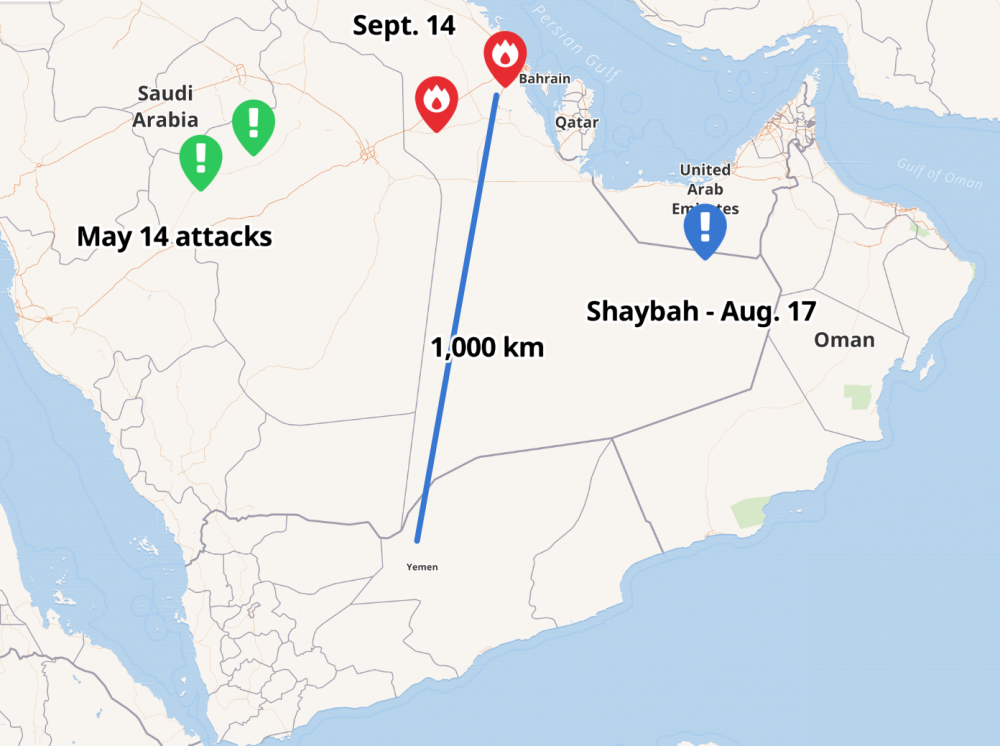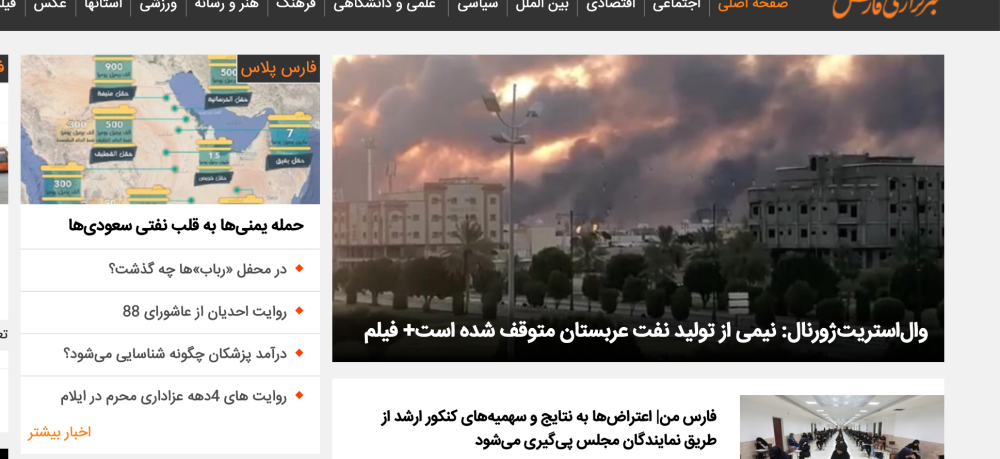Drone attacks caused large fires at an oil facility of Aramco in Saudi Arabia on Saturday morning. Two factories belonging to the company were targeted in Abqaiq and Khurais were targeted by drones, Saudi Arabia media reported.
These areas are very close to US bases in Bahrain, where the 5th fleet is located, and Al-Udeid in Qatar. It is also not that far from sensitive US facilities in Kuwait and UAE. How did drones penetrate this airspace without being detected by radar and air defense? These are important questions that come amid rising tensions in the region.

The attacks began around four in the morning and video showed massive fires, billowing smoke and locals reported explosions. They allegedly struck at the processing plant in Abqaiq (Buqayq) and the Khurais oil field.
Iranian media implied that the attacks were carried out by Houthi rebels in Yemen, who have been backed by Tehran. However the facilities that were struck are in northeastern Saudi Arabia, closer to Bahrain and Qatar. A drone would have had to fly 1,000 km to reach the facilities. Drone attacks from Yemen have usually targeted areas close to the Yemen border. Two exception stand out. First was a May 14 attack that also caused Aramco to stop pumping oil. That attack was later blamed,according to a US report in the Wall Street Journal on a paramilitary group operating from Iraq. The second case was the Shaybah attack in mid-August. Allegedly that attack was carried out by up to ten drones, according to the Houthis.

The full details of the most recent, September 14 attack, were not available on Saturday morning and it was not clear where the drones had come from. Iran has frequently boasted of new drone technology over the last nine months, including long-range drones. In early September Tehran unveiled the Kian long-range surveillance and attack drone. Iran’s Press TV is seeking to highlight the attack and blame it on a Saudi-led war in Yemen that has sought to support the Yemen government against the Houthis. The war has been controversial because it has been blamed for suffering in Yemen. Iran’s Press TV claims the “western-backed military aggression, coupled with a naval blockade, has killed tens of thousands.” Iran says this is a “quagmire” for the Saudis, and it is clear that there is a kind of proxy conflict taking place in Yemen. Every drone and rocket strike by the Houthis against Saudi Arabia is highlighted in Iranian media, as if it was an accomplishment by Tehran. This is because the technology for drones, ballistic missiles and air defense among the Houthis is linked to Tehran. For instance the Houthis have shot down at least two US drones over the past six months. There have been alleged splits in the Saudi-UAE coalition that has been fighting against the Houthis in Yemen. In addition separatists in Aden have caused rifts in the alliance against the Houthis.
The last month has seen the Yemen conflict heat up. A US drone was downed in mid-August and separatists briefly controlled parts of Aden. It took several hours for Saudi Arabia to confirm the fires at its oil facilities on Saturday morning. Most of the blazes appeared under control. But the attack was also a serious escalation. This is the third attack of this kind, a long-range strike on key oil infrastructure and shows that ability of the drone operator to carry out precision attacks. It also shows they have improved the ordnance carried by the drones. In addition it shows the drones can fly long-distances. Saudi Arabia, a key ally of the US, has not been able to interdict these long-distance strikes.
It has been able to bring down drones closer to the border with Yemen. Is this because Saudi air defense can’t operate at such long distances? Radar should be able to detect these incursions into Saudi airspace and present a clear picture of where the drones came from. The question then for Riyadh and Washington is how to interdict these drone strikes and also where to assign blame. Having drones striking facilities in key areas near Qatar, Bahrain and the UAE border is a major challenge.
It also comes amid the US-Iran tensions. Iran has been hard hit by sanctions and the US wants to drive Iranian oil exports to near-zero. Iran has said this is economic war and it has appeared to respond since May to US efforts. With discussions now about possible sanctions relief or France or other European powers stepping in to broker something, attacks on key oil facilities by a Tehran ally can be seen as pressuring western allies. It can also be seen as showing off drone technology.
Updates
Some more details emerged throughout the afternoon — images of the Shaybah damage from mid-August, video of the developing smoke at the facilities from the Sept. 14 attack, and an image of air defense ranges near the site of the attack. The @detresfa_ account has images also. Plumes of smoke can be seen along the pipeline and at the strike area., important context of Iran drone program.
Kuwait expresses support for Saudi Arabia. UAE also expresses support, calls the attack “terrorist.” Bahrain, Pakistan, and the US condemned the attack.
“Kuwait strongly condemns the drone attack on Saudi #Aramco facilities in Abqaiq and Khurais and calls on the international community to redouble efforts to combat Houthi attacks.” UAE: We stand fully with Saudi Arabia in combating all threats to its security and stability. U.S. Ambassador John #Abizaid: “The U.S. strongly condemns today’s drone attacks against oil facilities in Abqaiq and Khurais. These attacks against critical infrastructure endanger civilians, are unacceptable, and sooner or later will result in innocent lives being lost.”
CSIS even had a video four days before the attack of Abqaiq it put on Twitter. “Iran has the missile and cyber capabilities to significantly damage Saudi Arabia’s oil, desalination, electricity, and other important facilities.” The original video was put up in August.
One video posted from Kuwait alleges that drones overflew the area.
Afternoon of September 14
Saudi Arabia says it is cutting oil production due to the attack.
5:21pm. Reuters: “Saudi Arabia’s oil production and exports have been disrupted, said three sources familiar with the matter, after drone attacks on two Aramco plants on Saturday, including the world’s biggest oil processing facility. One of the sources said the attacks have impacted 5 million barrels per day of oil production, almost half the kingdom’s current output.”
What is now clear: “Saudi Aramco operates the world’s largest oil processing facility and crude oil stabilization plant in the world at Abqaiq, in eastern Saudi Arabia. The plant has a crude oil processing capacity of more than 7 million barrels per day.”
US Secretary of State Mike Pompeo releases statement. “Tehran is behind nearly 100 attacks on Saudi Arabia while Rouhani and Zarif pretend to engage in diplomacy. Amid all the calls for de-escalation, Iran has now launched an unprecedented attack on the world’s energy supply. There is no evidence the attacks came from Yemen.”

Read Seth J. Frantzman’s After ISIS: America, Iran, and the Struggle for the Middle East (Gefen, 2019), available on Amazon and Kindle
This is important because he says there is no evidence the attack came from Yemen. “No evidence” implies the US has evidence where it did come from. Joyce Karam writes: “Note also Pompeo reference that attacks on #Saudi may not have come from Yemen — the other suspect is Iraq . Either way this is a very dangerous situation involving multiple regional states, proxies. The Middle East, once again on the brink…” Saudi Arabia media reports the Pompeo comments.
The US is committed to well supplied oil markets, it says. “The United States strongly condemns today’s attack on critical energy infrastructure,” White House spokesman Judd Deere said in a statement. “Violent actions against civilian areas and infrastructure vital to the global economy only deepen conflict and mistrust.” Ali Shihabi notes “Saudi oil infrastructure is in effect global oil infrastructure. If Iranian attacks take Saudi exports offline then global oil and financial markets will provide a very painful reminder of this to all those who seem so nonchalant about the recent attacks.”
US President Donald Trump speaks on Saturday with Saudi Crown Prince Mohammed bin Salman.
Meanwhile the USS Ramage, a guided-missile destroyer, docks in Beirut.
Now it appears that half of Saudi oil production could be cut. That is seven percent of global supply, notes Liz Sly. Michael Pregent notes “RGC proxies in Iraq (Kataib Hezbollah) with the Houthis taking credit to mask Soleimani’s new front against the KSS from the Iraqi south.” Omri Ceren: “The Iranians just took 5% of global oil supplies off the market by having their Houthi proxies bomb Saudi energy infrastructure, but they’re offering to make it up if the U.S. lifts sanctions and enriches them, so that’s nice.”
At 7:41 pm Riyadh local time US Senator Lindsey Graham tweets “It is now time for the U.S. to put on the table an attack on Iranian oil refineries if they continue their provocations or increase nuclear enrichment.”

Later in the evening a new report says that a Kuwaiti paper has evidence the drone overflew Kuwait.
Saudi Arabia coalition spokesman says investigations underway about the drone attack. al-Arabiya and Al-Jarida report the investigation is under way. Saudi Arabia characterizes it as a terror attack and Saudi media stresses US support. UAE increases its rhetorical support for Riyadh.
September 15
“Critical processing infrastructure,” appears to have been struck according to satellite photos.
- Saudi Oil Production Under Attack, Expect Reprisals
- Saudi Oil Attacks Put Leftist Energy Stupidity In Stark Clarity


1 comment
Iran has shown us what their drones can do. Perhaps it’s time to remind Iran what our cruise missiles can do.